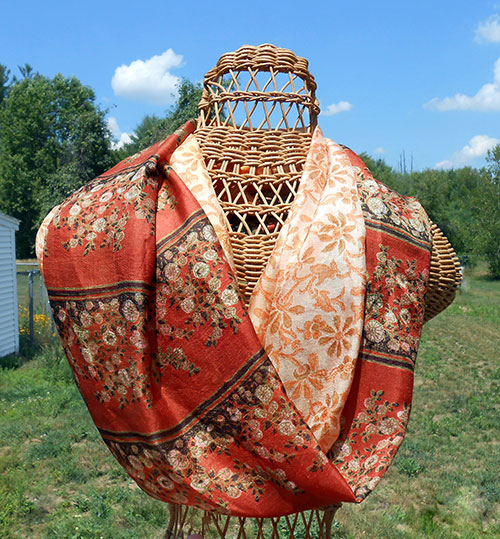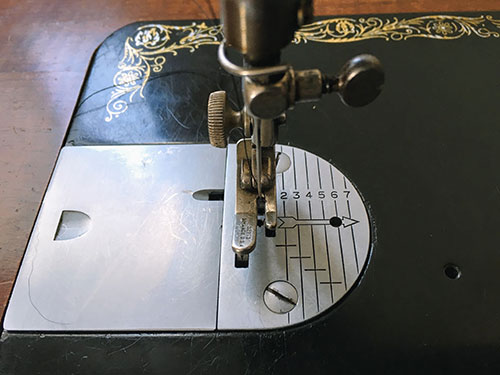How to Sew in a Straight Line
In this post, I'll go over my best tips and tricks for sewing in a straight line. When you first start sewing, you might notice that it's difficult to make sure your fabric feeds evenly, so that you can get a nice straight line of stitches. Even if you've been sewing for awhile, you might have trouble with this! Honestly, when I stop paying attention or sew too quickly, I still get wobbly seams sometimes. But if you follow these tips, and you pay careful attention, you should be able to sew in a nice straight line.
Disclosure: This post contains affiliate links, which means I may receive a percentage if you make a purchase using these links. This won’t cost anything extra to you. I only link to things I like and use, and the proceeds help me to run this blog. Thank you for supporting me!
Using Guide Lines to Sew in a Straight Line
Using the guide lines on the needle plate is one of the easiest ways to sew in a straight line. Provided your sewing machine has guide lines on the needle plate, it doesn't require any extra gadgets or purchases!
My Singer Fashion Mate (below), has guide lines on both sides of the needle to help you sew standard-sized seams.
When sewing, make sure you watching the fabric, rather than the needle. Watch the spot right at the front of the guide line, and make sure the fabric stays even as it approaches the guide line. Don't push or pull the fabric, as this can cause the needle to become misaligned--just gently guide it.
I'm sewing along the 5/8" line below. I like to keep the fabric just to the left of the line, so I can see the line clearly.
If you read this blog regularly, you know that I love vintage sewing machines. However, these machines often don't have guide lines on their needle plates. Luckily, you can often buy new plates with guide lines.
This Singer 66 initially came with a blank needle plate, but I swapped it out for one with guide lines.
Here's a close up of the new needle plate. The lines are numbered for each 1/8" from the needle (e.g. 2 = 1/4", 3 = 3/8", 4 = 1/2", etc.). The short perpendicular lines show where you should stop to turn a corner and maintain the same seam allowance. I wish my modern sewing machine had these lines!
Here are some common vintage sewing machines that you can buy new needle plates for:
- Singer 15 & Singer 201
- Singer Featherweight 221/222
- I had a little difficulty finding a new needle plate for the Singer 66, but if you keep an eye on Ebay, you may be able to find one, too.
- Sewing Parts Online has a good selection of needle plates as well, and you can use their search function to find all parts compatible with your sewing machine.
Using Presser Feet to Sew in a Straight Line
One of the easiest ways to sew in a straight line is to use the edge of your presser foot as a guide. Be sure to watch the area right before the presser foot to keep the fabric feeding evenly with the edge of the presser foot.
When you need a 1/4" seam, a quarter inch foot is really useful. It has a little guide along side that keeps the fabric from sliding off to the side. If you need to sew a seam larger than 1/4", you can try this adjustable guide foot.
The quarter inch foot does a great job of keeping the fabric right in line!
If you need to sew parallel rows of stitches for a quilted project, the border guide foot is really useful. You can line up your previous row of stitches with one of the red guide lines on the otherwise clear presser foot. I used to have a really tough time keeping my quilting lines evenly space and straight before I found this foot!
Using Magnetic Guides to Sew in a Straight Line
For metal sewing machines, you can use a magnetic seam guide to help feed your fabric in a straight line. I would not recommend this for computerized sewing machines, as you don't want a strong magnet near those electronic parts.
The magnet on this one is very strong, and it's almost difficult to remove and reposition. On machines that already have some peeling paint, like my industrial sewing machine, I was worried it might damage the finish further. I don't think it's done any damage so far, but I don't use it that much because it still concerns me.
This magnetic seam gauge is smaller. The magnet holds well, but it isn't as difficult to reposition as the other one. I wish it had a little knob like the previous one, and that it was a little bit longer, but it's still useful.
Using a Cloth Edge Guide to Sew in a Straight Line
Another useful tool is the cloth edge guide, which looks like a little shovel and screws into a hole on your sewing machine. It keeps your fabric from wandering off course and makes it so that you can sew in a nice straight line.
The one below came with my Singer 99k, but you can often find them in lots of vintage sewing parts.
Many modern machines have screw holes for these cloth guides as well!
Other Ways to Sew in a Straight Line
Here are a few more tips for sewing a perfectly straight line on your sewing machine.
I've seen people put a line of masking tape on their sewing machine to provide a longer guide against which to align your fabric.
There's also a tutorial for mounting a laser on your sewing machine to provide a guide.
I hope all of these tips provided you with some ideas for how to sew in a straight line! Which of these methods do you use? Are there any you want to try out after reading this post? Let me know in the comments!




















